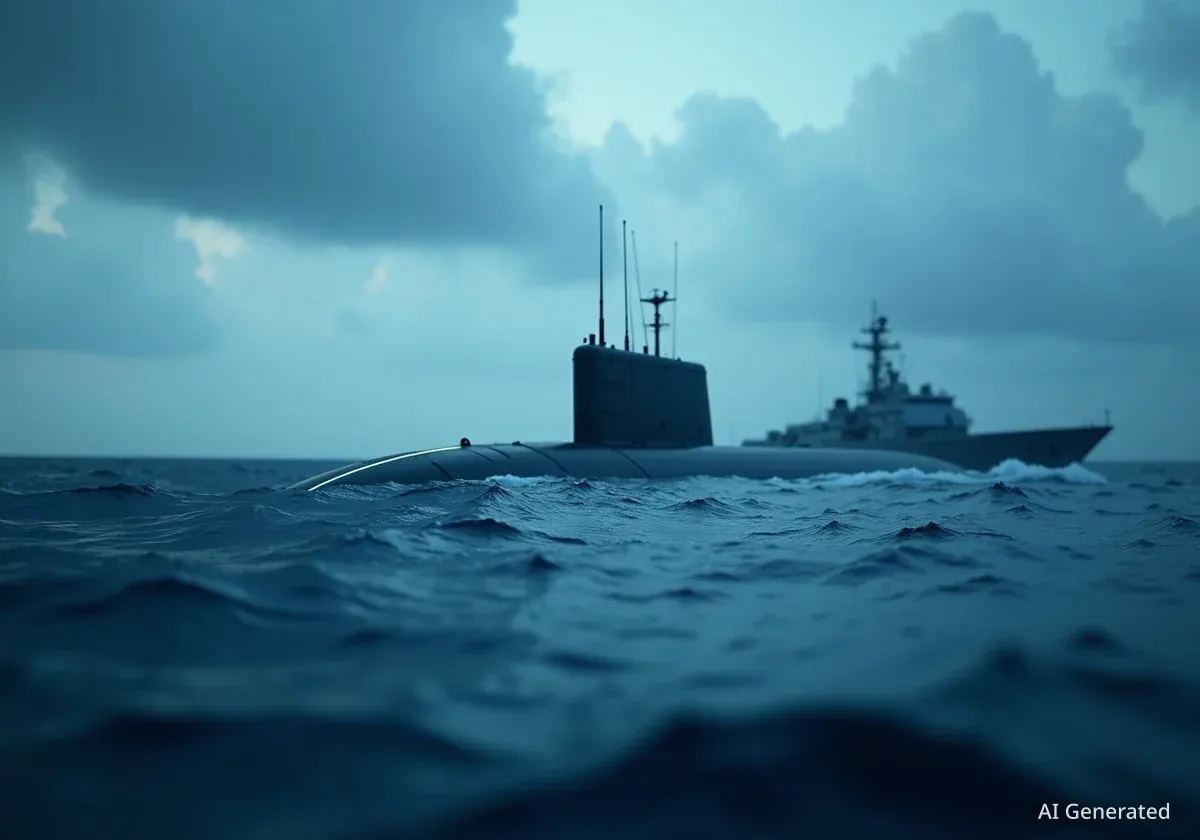A research team in China has announced the development of an artificial intelligence system they claim can detect even the most advanced stealth submarines with a 95% success rate in simulations. This development, if proven effective in real-world conditions, could significantly alter the strategic balance of global naval power.
Key Takeaways
- Chinese researchers published a study on an AI system for anti-submarine warfare, claiming a 95% detection rate in simulations.
- The system reportedly analyzes multiple data sources, including sonar, water temperature, and salinity, to track targets in real time.
- Western experts express skepticism, citing the complexity of the underwater environment and the ongoing technological race between detection and stealth.
- The technology could impact the nuclear triad, which relies on the undetectability of ballistic missile submarines for strategic deterrence.
A New Approach to Submarine Detection
The study detailing the new AI system was published in the Chinese journal Electronics Optics & Control. According to the report, the China Helicopter Research and Development Institute, led by chief engineer Meng Hao, is behind the technology. The system is designed to process vast amounts of data from various sensors simultaneously.
These sensors include traditional tools like sonar buoys and underwater microphones, but also environmental factors such as water temperature and salinity. By integrating this information, the AI creates a comprehensive and dynamic map of the underwater environment, allowing it to identify and track submerged vessels with high precision.
The researchers claim the system is advanced enough to counter common evasion tactics. In computer simulations, it successfully identified targets despite countermeasures like zigzag maneuvers, the use of decoys, or the deployment of drones. This suggests a significant leap in anti-submarine warfare (ASW) capabilities.
Simplifying Complex Data
A key feature of the reported AI is its ability to translate complex underwater data into simple, actionable instructions for military personnel. This function is designed to improve decision-making speed and accuracy, especially in high-stress combat situations.
Strategic Implications for Global Powers
The ability to reliably detect stealth submarines would have profound consequences for international security. For decades, the foundation of nuclear deterrence for major powers—often called the "nuclear triad"—has rested on three pillars: land-based missiles, strategic bombers, and submarine-launched ballistic missiles (SLBMs).
The submarine component has always been considered the most survivable, as nuclear-powered ballistic missile submarines (SSBNs) can remain hidden in the ocean's depths for extended periods. This ensures a nation can retaliate even if its land-based and air-based assets are destroyed in a first strike. A system that renders these submarines vulnerable could destabilize this long-standing doctrine.
"Entire naval fleets, which have so far relied on the strategic hide-and-seek tactics of nuclear-powered submarines, would face uncertainty if their submarine capabilities were threatened."
The Geopolitical Context of the South China Sea
This technological claim comes as China continues to expand its naval presence, particularly in the South China Sea and the Taiwan Strait. Currently, China's submarine fleet operates primarily from bases on Hainan Island, where the shallow waters make them relatively easy to track upon departure.
Gaining control over Taiwan would provide China's submarines with direct access to the deep waters of the Pacific Ocean. This would dramatically increase their operational range and stealth, making them a more credible nuclear deterrent. The development of advanced ASW technology aligns with these broader strategic ambitions.
Expert Analysis and Skepticism
While the Chinese claims are significant, many Western military experts remain cautious. They point out that success in a computer simulation does not guarantee effectiveness in the complex and unpredictable real-world ocean environment.
A Continuous Technological Arms Race
The history of naval warfare is a constant struggle between stealth and detection. Every new advancement in tracking technology is met with new methods of camouflage and evasion. This dynamic, often described as a "cat and mouse" game, means that no single technology is likely to provide a permanent advantage.
Paul S. Schmitt, a U.S. expert on naval warfare affiliated with the Naval War College, noted that while AI can enhance submarine hunting by processing large data sets, its practical implementation is challenging. He described the concept of a fully integrated, AI-controlled detection network as an "interesting goal for the future" but suggested it remains optimistic for now.
German security experts have echoed this sentiment, emphasizing that maritime defense and attack technologies must evolve continuously in response to one another. The outcome of this arms race remains uncertain.
The Global Submarine Landscape
Understanding the balance of underwater power provides context for these developments. While China has the largest number of submarines overall, the strategic competition focuses on the most advanced nuclear-powered vessels.
Submarine Fleet Sizes by Nation:
- China: 105 submarines
- North Korea: 90 submarines
- United States: 74 submarines
- Russia: 62 submarines
When it comes to the crucial SSBNs, the United States holds a significant lead with approximately 14 Ohio-class submarines and over 50 modern attack submarines. Russia follows with around 16 strategic submarines. China is rapidly expanding its fleet, which includes at least six Jin-class SSBNs.
Other nuclear powers like the United Kingdom and France maintain smaller but technologically advanced SSBN fleets. Meanwhile, nations like Germany are leaders in conventional diesel-electric submarine technology, which offers different tactical advantages. The ultimate impact of China's claimed AI system will depend on its ability to overcome the challenges of real-world deployment and the countermeasures that will inevitably be developed in response.





